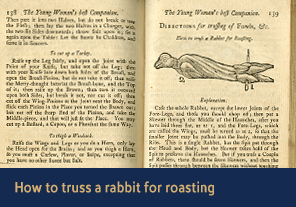Digital GalleryExplore
Explore how to truss small game for cooking
In the 18th century English cookbooks often included useful information in addition to the expected dinner recipes. Sarah Jackson's The Director: or Young Woman's Best Companion (London, 1770) features eight illustrations showing how to truss fowl and game, accompanied by step-by-step explanations. Trussing was an important skill in an 18th-century kitchen where roasting took place on a spit over an open fire. If a cook did not truss the wings of a fowl, or the long legs of a hare, they might flop about and burn, or throw off the balance of a spit. Jackson's trussing instructions, written in simple language, were likely intended for servants.
-

1. Title page from Young Woman's Best Companion
Title page from Sarah Jackson, The Director: or Young Woman's Best Companion, London, 1770
Courtesy National Library of Medicine
As described on this page, Sarah Jackson's The Director: or Young Woman's Best Companion (London, 1770) offers a plethora of 'plain' information for family cooks. In addition to three hundred easy recipes, it contains instructions for choosing the best foods at market; directions for carving meats and making wines; menus suggestions by month; and cures for illnesses and maladies. You can view the entire book here.
-

How to truss a rabbit for roasting
How to truss a rabbit for roasting from Young Woman's Best Companion, 1770
Courtesy National Library of Medicine
As Jackson explains on the right hand page, to prepare a single rabbit for roasting on a spit a cook needs to 'case' (skin) it, cut off the lower joints of its 'wings' (forelegs), skewer it together in two places, and then pass a spit through its head and body.
-

How to truss a rabbit for boiling; how to truss a hare
How to truss a rabbit for boiling; how to truss a hare from Young Woman's Best Companion, 1770
Courtesy National Library of Medicine
On these two pages Jackson describes how to compactly truss a rabbit or a hare before boiling it in a pot over a fire. In the case of the hare, the cook needs to skewer the animal in seven places from head to 'scut' (tail), including putting two skewers in the ears to make them almost stand upright.
-

How to truss a pigeon; how to truss a fowl for boiling
How to truss a pigeon; how to truss a fowl for boiling from Young Woman's Best Companion, 1770
Courtesy National Library of Medicine
Pigeons were commonly eaten in the 18th century. Jackson explains here how to truss a small pigeon using a single skewer passed between 'the brown of the leg and the bent of the thigh.' She also describes how to truss a fowl for boiling without using any skewers. The cook must 'beat down' the breastbone, cut off the 'claws of the feet,' cut a hole in the apron just above 'the sideman,' and put the joints of the leg into the body
-

How to truss goose; how to truss easterlings, ducks, teals, and widgeons
How to truss a pigeon; how to truss a fowl for boiling from Young Woman's Best Companion, 1770
Courtesy National Library of Medicine
On these two pages Jackson describes how to truss a goose with two skewers, and how to truss smaller birds such as easterlings, ducks, teals, and widgeons with one skewer. In each case the cook must first gut the bird and remove the 'pinions' (the outer wing tips). To truss a smaller bird, in a series of coordinated steps the cook must raise up the legs, twist the feet and bring them toward the body, and insert a skewer between the lower joint next to the thigh and foot.
-

How to truss a partridge or pheasant
How to truss goose; how to truss easterlings, ducks, teals, and widgeons from Young Woman's Best Companion, 1770
Courtesy National Library of Medicine
In this illustration and accompanying explanation, Jackson describes how to truss a partridge or a pheasant, both of which have bony legs. 'Drawing' in the second paragraph refers to process of removing the partridge or pheasant's crop, liver, and others innards in preparation for cooking.








